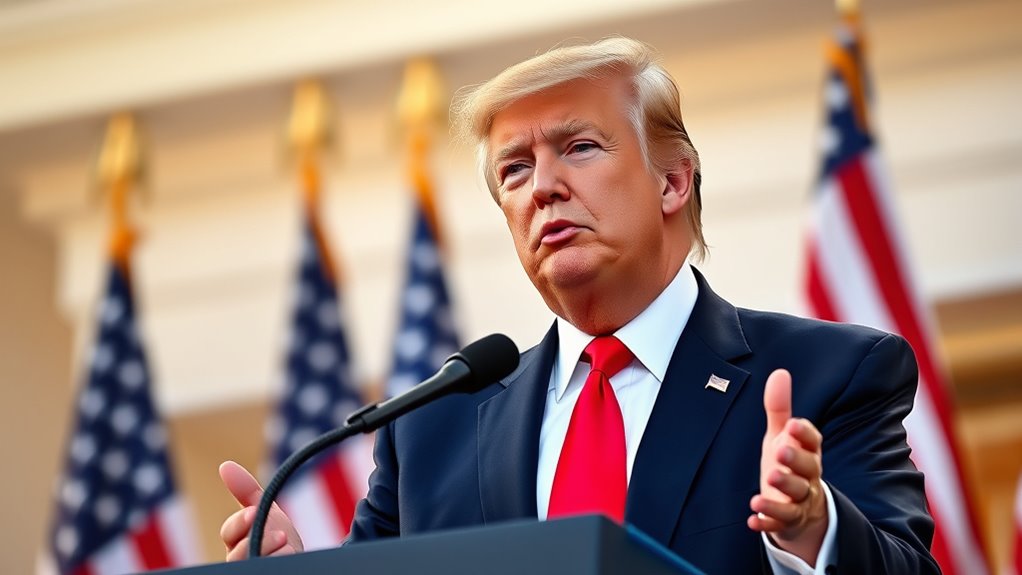Donald Trump, the 45th President of the United States, was known for his unconventional approach and impactful policies. He won in 2016 despite losing the popular vote and focused on reshaping the economy, immigration, and the judiciary. His administration implemented major tax cuts, confirmed conservative Supreme Court justices, and adopted tough trade policies. His presidency also sparked controversy with executive orders and investigations. To understand how his influence still shapes U.S. politics today, explore further details below.
Key Takeaways
- Donald Trump served as the 45th President of the United States from 2017 to 2021.
- He won the 2016 election with 304 electoral votes despite losing the popular vote.
- Trump is known for his conservative policies, judicial appointments, and controversial executive actions.
- His presidency included significant tax reforms, immigration restrictions, and deregulation efforts.
- Trump remains a influential figure in Republican politics and continues to shape national political discourse.
Election and Inauguration
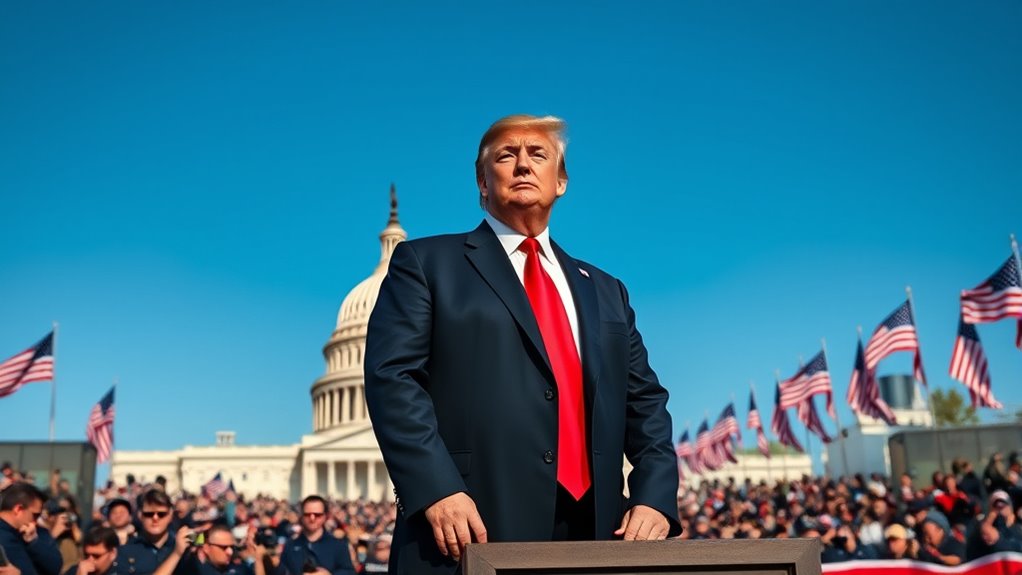
How did Donald Trump manage to win the 2016 presidential election despite losing the popular vote? You see, he secured 304 electoral votes, enough to win, even though Hillary Clinton received about 2.9 million more votes nationwide. Trump’s victory relied heavily on winning key swing states like Florida, Iowa, and Ohio, especially in the Rust Belt. His strategy overturned Democratic strongholds in Michigan, Pennsylvania, and Wisconsin. Despite Clinton outspending him two-to-one, Trump’s appeal to white working-class voters and his focus on electoral college dynamics paid off. Seven faithless electors briefly defected, but Trump still finished with a solid electoral count. His inauguration on January 20, 2017, marked a historic upset, emphasizing the importance of the Electoral College system in U.S. elections. Additionally, the election highlighted the significance of electoral college dynamics, which played a crucial role in the outcome.
Domestic Policy and Legislative Achievements
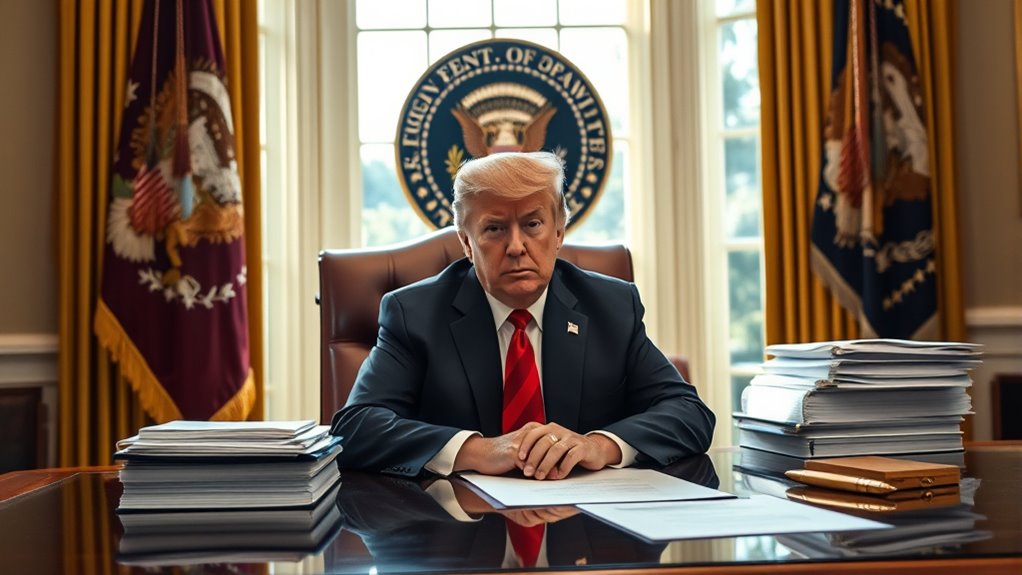
Donald Trump’s presidency brought significant shifts in domestic policy, marked by sweeping legislative changes and executive actions aimed at reshaping the American economy and society. You saw the enactment of the Tax Cuts and Jobs Act of 2017, which lowered corporate taxes from 35% to 21% and cut individual rates to boost growth. You also witnessed efforts to reform criminal justice with the First Step Act and easing regulations on banks through partial Dodd–Frank repeal. Immigration policies became more restrictive, including efforts to build a border wall, reduce refugee admissions, and limit legal immigration with proposals like the 2017 RAISE Act. Additionally, you saw initiatives to deregulate industries, respond to natural disasters, and attempt to dismantle the ACA, all shaping the political landscape during his tenure. Furthermore, the administration pursued policies aimed at promoting American manufacturing and renegotiating trade deals to favor U.S. interests. These efforts often involved regulatory reforms that aimed to reduce burdens on businesses and stimulate economic growth.
Judicial Appointments and Their Impact
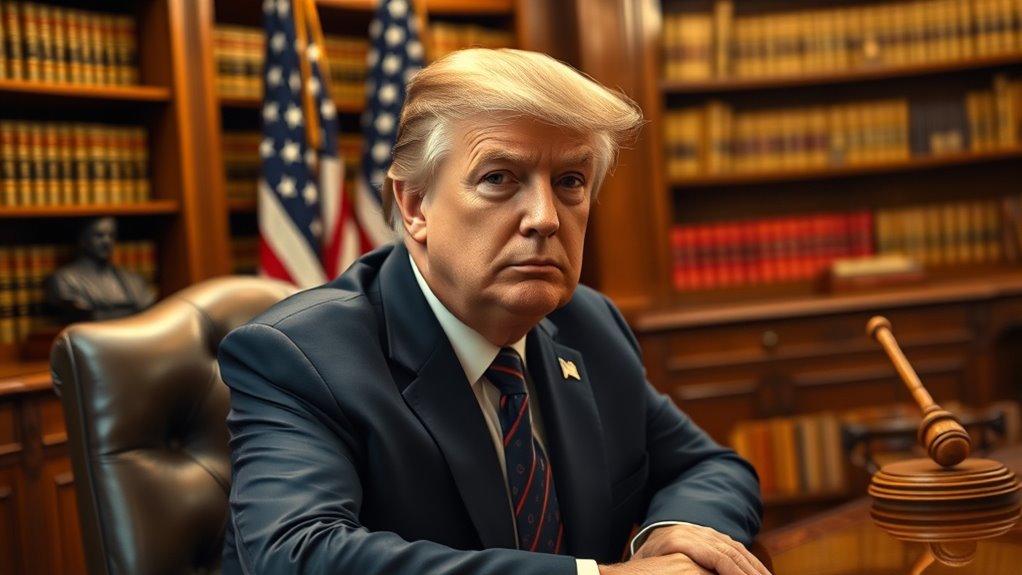
You can see how Trump’s judicial appointments have considerably shifted the Supreme Court’s ideological balance toward conservatism. These choices also reshaped federal appellate courts, influencing legal decisions nationwide for years to come. As a result, his legacy includes a lasting impact on American law and constitutional interpretation. Moreover, the president’s focus on selecting judges with a conservative judicial philosophy has ensured that his influence extends well beyond his time in office. Additionally, the emphasis on environmental considerations in his judicial choices reflects a broader impact on policies related to natural resources and conservation efforts.
Supreme Court Shift
Have you ever wondered how a president’s judicial appointments can reshape the Supreme Court? During Donald Trump’s presidency, he nominated three justices—Neil Gorsuch, Brett Kavanaugh, and Amy Coney Barrett—shifting the Court to a solid conservative majority. Gorsuch filled Justice Scalia’s vacancy after Senate confirmation, which involved rule changes lowering the vote threshold. Kavanaugh and Barrett’s appointments further reinforced conservative dominance. Trump’s strategic release of multiple nomination lists reassured conservatives he’d prioritize their judicial philosophy. These appointments, along with 55 appellate judges, flipped many federal courts to Republican control, influencing legal decisions nationwide. Overall, Trump appointed 238 federal judges, profoundly shaping the judiciary. This shift impacts the Court’s ideological landscape, reinforcing conservative interpretations of the Constitution for years to come. This extensive judicial influence will likely shape legal precedents for decades.
Federal Judicial Legacy
How have Trump’s judicial appointments shaped the federal judiciary, and what long-term effects might they have? Your actions notably altered the courts’ ideological balance and composition, with lasting implications. Consider these key points:
- Trump appointed 226 federal judges, including 234 Article III judges, reshaping court ideologies.
- His appointments increased the number of appellate judges, making courts more conservative.
- Federal judges serve lifetime terms, meaning his influence endures well beyond his presidency.
- The gluten-free options available in crepes demonstrate the adaptability of traditional recipes to modern dietary needs.
These appointments have shifted court dynamics, impacting legal decisions for decades. His strategic timing and collaboration with Senate Republicans accelerated confirmations, ensuring a lasting legacy. The demographic makeup, mainly White judges, highlights a specific ideological and demographic shift. Overall, Trump’s judicial legacy will influence U.S. law and policy long after his tenure concludes.
Foreign Policy Initiatives and Trade Negotiations
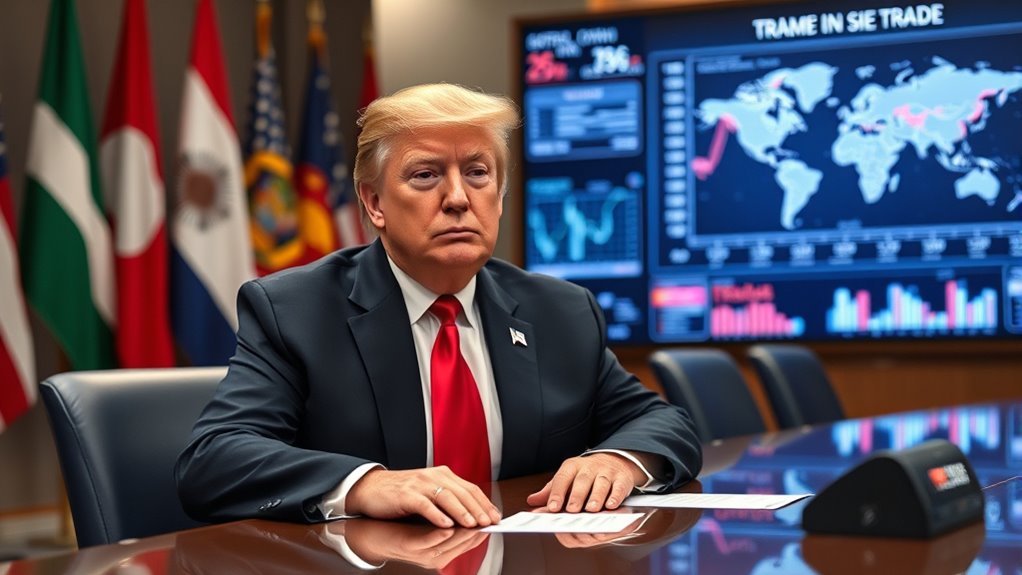
You’ll see that Trump’s tariff strategies aimed to protect American industries but also sparked retaliations and trade tensions. His Middle East moves, like recognizing Jerusalem and brokering the Abraham Accords, shifted U.S. policy and reshaped regional relations. These initiatives reflect a focus on assertive diplomacy and economic measures to advance U.S. interests globally. Additionally, his approach to foreign support hours emphasized efficiency and responsiveness in diplomatic efforts.
Tariff Strategies and Effects
Under Donald Trump’s administration, tariff strategies became a central tool for shaping foreign policy and negotiating trade deals. You saw a 10% universal tariff on all countries from April 2025, along with higher reciprocal tariffs targeting nations with the largest deficits. These tariffs aimed to counteract nonreciprocal practices like currency manipulation and protect national security by reducing reliance on foreign supply chains. Key points include:
- Significant tariff hikes on steel (up to 50%), aluminum, and imported cars to boost domestic manufacturing.
- Heavy tariffs on China, reaching 145%, and targeted increases on countries like Brazil.
- Tariffs generated over $100 billion in revenue, but also increased costs for U.S. consumers and businesses, influencing diplomatic negotiations and trade agreements.
These strategies reflected a long-term effort to reshape trade relations and protect American interests.
Middle East Peace Moves
During Donald Trump’s administration, Middle East peace efforts focused on strengthening diplomatic ties and promoting economic cooperation. You saw the signing of the Abraham Accords, which normalized relations between Israel and Arab states like the UAE, Bahrain, and Sudan, reducing regional tensions. Efforts to stabilize Syria included lifting sanctions and engaging with new leadership to counter Iran’s influence. Trump’s team also negotiated with Hamas, despite Israeli opposition, and worked to revive Iran nuclear talks to address regional security concerns. Military cooperation with Saudi Arabia and Gulf states aimed to counter Houthi aggression in the Red Sea. These initiatives fostered trade, security alliances, and regional stability, aligning U.S. interests with broader diplomatic and economic strategies to shape a more stable Middle East. Additionally, the administration emphasized home improvement strategies to enhance regional infrastructure and support economic stability in partner nations.
Executive Orders and Controversial Actions
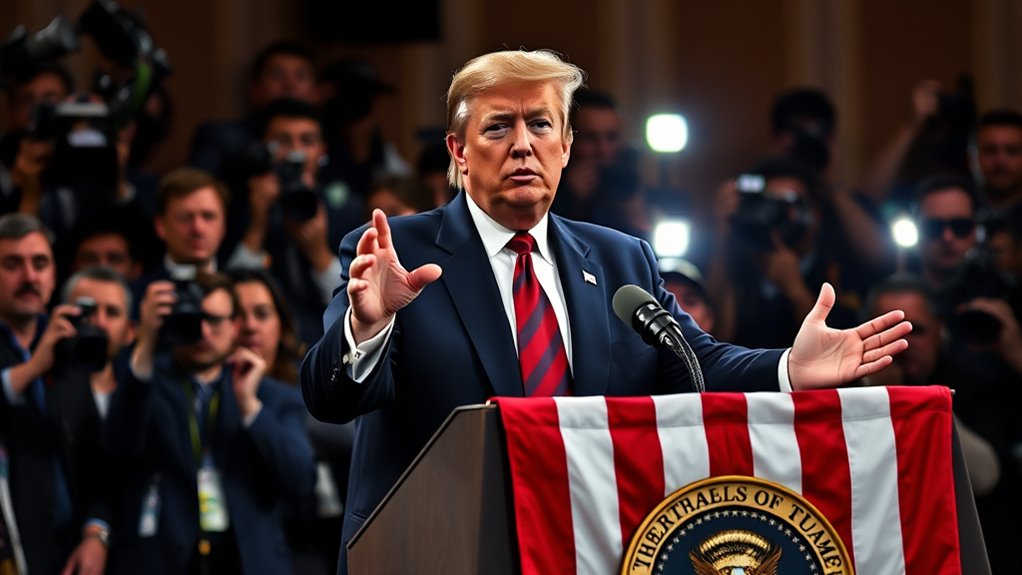
Donald Trump’s presidency was marked by a series of executive orders that sparked significant controversy and debate. You might have noticed how these actions affected many areas of life:
Donald Trump’s executive orders sparked controversy and impacted multiple areas of life.
- Restricting the entry of foreign nationals from certain countries, raising concerns about international relations and security. These policies also impacted immigration procedures and the lives of many immigrants.
- Suspending nonimmigrant visas at Harvard, which sparked questions about academic freedom and collaboration.
- Revoking Syria sanctions, provoking criticism over efforts to hold the Syrian government accountable. The sanctions and their revocation played a role in shaping international diplomacy and foreign policy strategies.
Major Domestic and International Challenges
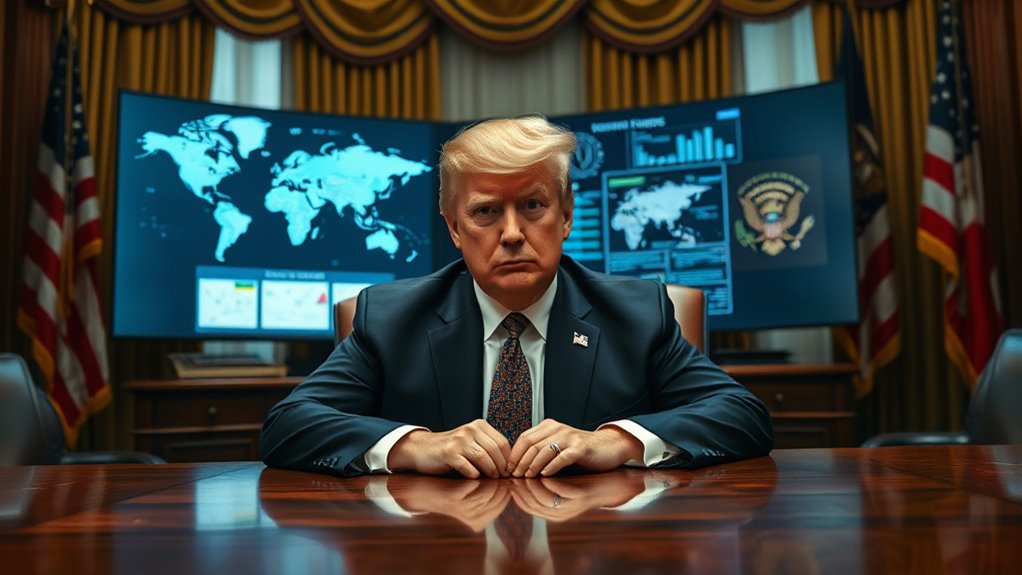
As you consider Trump’s presidency, you see how political polarization and divisiveness fueled ongoing conflicts within the country and abroad. Legal investigations and pressures added to the turmoil, challenging his leadership at every turn. Meanwhile, international relations tensions tested the U.S.’s global influence, shaping a complex landscape of challenges for his administration. Policy shifts and executive actions further complicated the domestic environment, impacting industries and economic stability.
Political Polarization and Divisiveness
Have you ever wondered why political divisions in the United States feel more intense than ever? It’s because economic, social, and emotional factors deepen the divide. Here’s what fuels it:
- Income inequality and economic disparities influence voting, creating stark contrasts between groups.
- Racial tensions and social issues, like immigration, heighten divisions, with perceptions differing sharply between parties.
- Affective polarization fuels emotional reactions, making ideological differences seem bigger than they are, especially among the most engaged voters.
- Experts’ assessments indicate that perceptions of threats to democracy, such as actions by political leaders and erosion of democratic norms, further intensify polarization and mistrust across political lines. Perceptions of threats to democracy shape voter attitudes and deepen divisions.
- The influence of AI-driven data analytics in political campaigns can amplify existing biases and contribute to further polarization by targeting messages to specific voter segments, reinforcing their beliefs.
Trump’s policies and support base further reinforce these divides, with party loyalty often outweighing policy debates. As partisanship deepens, the emotional and identity-based aspects of politics drive polarization, making compromise increasingly difficult and shaping the country’s political landscape.
Legal and Investigative Pressures
Legal and investigative pressures have considerably challenged Trump’s presidency and post-presidential pursuits, revealing the complexities of holding a former leader accountable. You see, his administration faced frequent legal challenges, especially for violating the Administrative Procedure Act, and lost a key Supreme Court case over DACA. Executive orders and actions often faced court scrutiny for transparency issues and legal flaws. Meanwhile, investigations into Trump’s finances led to subpoenas, lawsuits, and court rulings requiring the release of his tax records. Personal legal issues also arose, including liability for sexual misconduct and ongoing lawsuits. Internationally, his policies prompted sanctions and legal challenges against organizations like the ICC. These pressures, fueled by media scrutiny and legal battles, continue to shape Trump’s political and business future. Ongoing investigations and lawsuits continue to pose significant hurdles for him. Additionally, his public image remains a focal point of controversy, affecting both legal proceedings and political support.
International Relations Tensions
International relations during Trump’s presidency were marked by heightened tensions and bold moves that reshaped U.S. diplomacy. You see, he took a confrontational stance on key issues, challenging traditional alliances and policies. Here are three ways he intensified international tensions:
- Moving the U.S. embassy to Jerusalem, which upset longtime efforts for peace in the Middle East.
- Imposing harsh sanctions on Iran, despite mixed feelings about their effectiveness.
- Engaging in a trade war with China, disrupting global markets and sparking ongoing economic disputes.
Trump’s approach to North Korea also shifted from confrontation to dialogue, with historic summits, but no denuclearization. Meanwhile, he pushed European nations to support Ukraine, signaling a shift in geopolitical responsibility. His unpredictable diplomacy and reluctance to commit to long-term strategies further complicated international efforts to address conflicts and alliances. Recognizing the importance of Cultural Intelligence in navigating these complex relationships is vital for understanding the global impact of his policies.
Economic Policies and Fiscal Impact
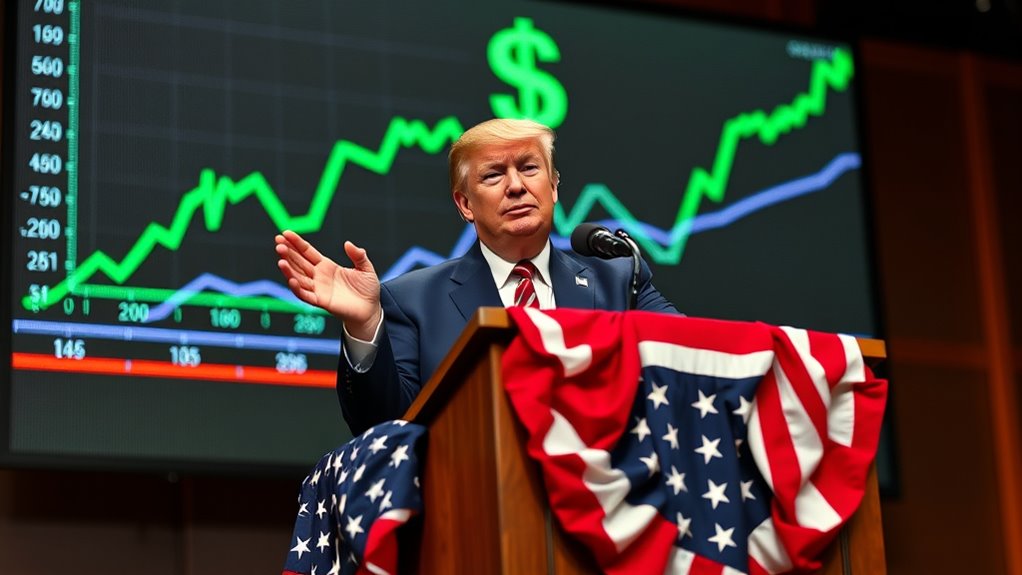
During Donald Trump’s presidency, his economic policies centered on significant tax cuts, deregulation, and aggressive trade actions, all of which aimed to stimulate growth. The 2017 Tax Cuts and Jobs Act reduced corporate rates from 35% to 21% and lowered individual taxes, boosting short-term economic activity. However, these cuts increased federal deficits and national debt, especially amid rising spending and pandemic-related costs. Trump’s deregulation efforts removed nearly 100 federal rules, reducing compliance burdens but raising environmental concerns. His trade policies, including tariffs on steel, aluminum, and Chinese imports, disrupted supply chains and affected industries differently. While these policies spurred business confidence and GDP growth for a time, they also contributed to larger deficits, increased debt, and economic uncertainty.
Key Reforms and Social Movements
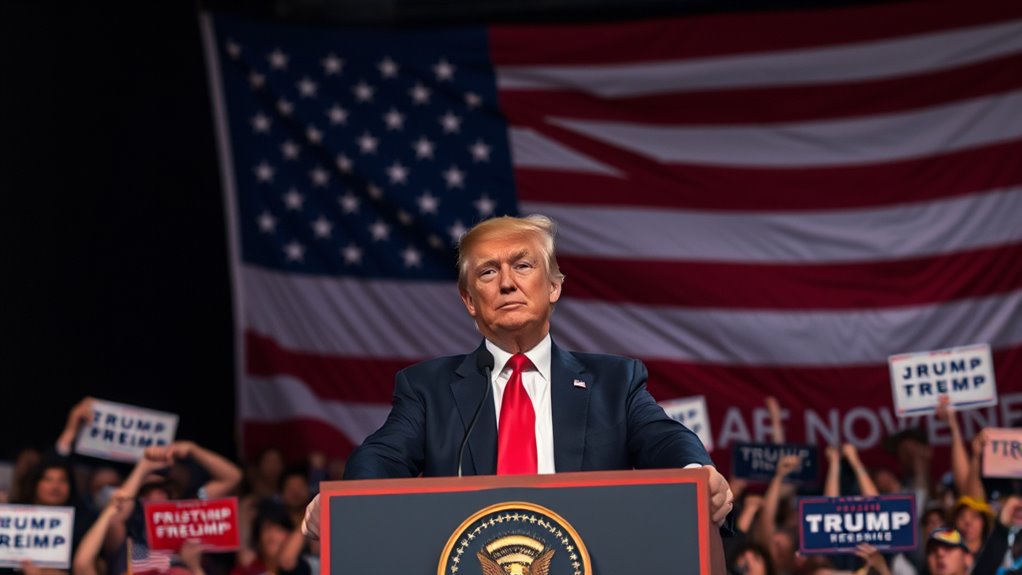
What were the most significant reforms and social movements under Donald Trump’s presidency? You’ll see a focus on major policy shifts and social changes that shaped his era. Here are three key areas:
- Tax and Regulatory Reforms: The Tax Cuts and Jobs Act slashed taxes for individuals and corporations, while deregulation efforts, like rolling back environmental protections, aimed to boost industry. Early in his term, Trump also prioritized reducing federal regulations, suspending or revoking nearly 100 rules to foster economic growth.
- Immigration and Civil Rights: Travel bans and stricter immigration policies marked a hardline stance, alongside rollbacks on civil rights protections, impacting marginalized groups.
- Healthcare and Judicial Changes: Eliminating the individual mandate reduced healthcare costs, and swift judicial nominations reshaped the federal bench, emphasizing conservative values. These reforms reflect a presidency driven by significant policy shifts and social movements that continue to influence the nation.
Post-Presidency Legacy and Continuing Influence
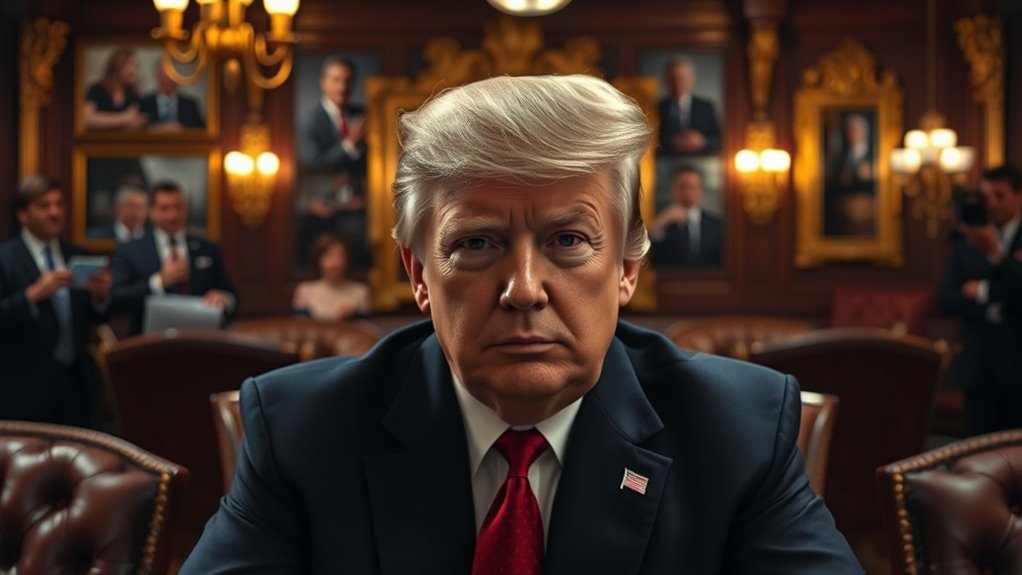
Donald Trump’s influence continues to shape American politics long after leaving office, as his executive actions and policy priorities remain highly relevant. His orders, like those on environmental conservation and foreign sanctions, set ongoing precedents that future administrations must navigate. You’ll see his political ideology still guiding Republican policies, with his support base remaining active and influential. His strong media presence affects political discourse and election outcomes. Economically, his tax cuts, deregulation, and trade policies continue to impact markets and government spending. Socially, his social media use, immigration stance, and role in polarization shape public debates. Legally, his judicial appointments and executive power assertions leave a lasting mark on the courts and constitutional discussions. His legacy endures, influencing policies and political dynamics across the U.S.
Notable Controversies and Investigations
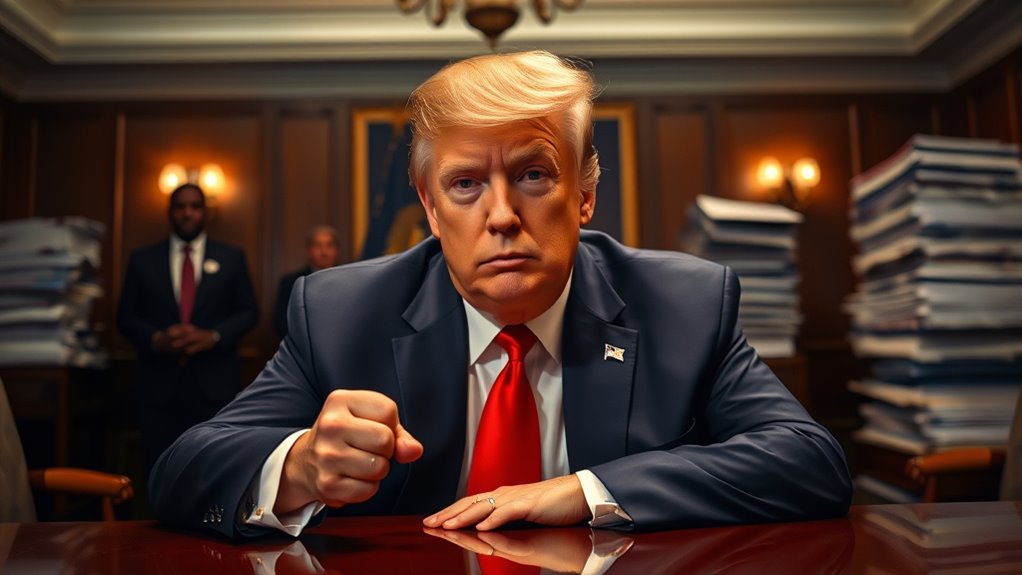
Many of Donald Trump’s actions in office sparked intense scrutiny and led to numerous controversies and investigations. You might find it surprising how conflicts of interest, transparency failures, and ethical breaches marked his presidency. For example:
Trump’s presidency was marked by conflicts of interest, transparency issues, and ethical breaches.
- His family members, Ivanka Trump and Jared Kushner, held White House roles despite legal precedents against nepotism and benefited financially from government programs.
- The administration resisted transparency efforts, with agencies hiding meetings and Trump suing Congress to block information release.
- Trump’s refusal to divest from his businesses resulted in thousands of conflicts of interest, while his COVID-19 response faced criticism for cronyism and ethical lapses involving Kushner’s shadow task force.
These controversies cast long shadows over his presidency, raising questions about integrity and accountability.
Frequently Asked Questions
What Were Trump’s Most Controversial Statements During His Presidency?
Your question about Trump’s most controversial statements highlights his tendency to make bold, polarizing remarks. He often claimed the election was stolen, questioned the legitimacy of the media, and called COVID-19 the “China virus.” His remarks on immigration, such as family separations and the border wall, sparked outrage. These statements fueled debate, deepened divisions, and drew widespread criticism from opponents and supporters alike.
How Did Trump’S Policies Affect the U.S. Economy Long-Term?
Imagine a rising tide lifting all ships—Trump’s policies aimed to boost growth, deregulation, and tax cuts. But like a tide that also exposes hidden reefs, these actions increased the national debt and trade deficits, creating long-term risks. You might see a resilient economy now, yet future stability depends on how these currents are managed. The long-term impact’s a mixed landscape, shaped by both economic gains and looming fiscal challenges.
What Legal Challenges Did Trump Face After Leaving Office?
You’d see that post-office, you face various legal challenges, including Section 3 of the 14th Amendment debates about disqualifying from future office, criminal indictments linked to January 6th, and ongoing court rulings on actions taken while in office. You also encounter international disputes like ICC sanctions and domestic issues such as immigration policies and executive orders, which continue to be scrutinized and challenged legally.
How Has Trump Influenced the Republican Party Since 2021?
Have you wondered how one person’s influence can reshape an entire party? Since 2021, you see Trump’s impact through the rise of the MAGA movement, increased polarization, and shifts toward populist policies. You notice party loyalty leaning heavily on his agenda, even amid internal conflicts with traditional Republicans. His push for radical reforms and aggressive rhetoric have redefined the party’s direction, making it more divided and intensely focused on his vision.
What Are the Ongoing Investigations Related to Trump’S Presidency?
You’re asking about ongoing investigations related to a recent presidency. These include inquiries into potential financial misconduct, such as tax and business practices, as well as federal and state-level probes into possible interference with elections. Special counsels and grand juries are examining these issues, and some investigations focus on handling classified information. The legal process is ongoing, with many cases still unresolved, keeping the political landscape highly scrutinized.
Conclusion
As you reflect on Donald Trump’s presidency, you’ll see how he reshaped America’s political landscape. His administration’s policies led to a 3.5% GDP growth in 2019, the highest in four years, showcasing his economic impact. Despite controversies, his influence persists, shaping future debates and elections. Trump’s leadership proves that bold, unconventional actions can leave a lasting legacy—reminding you that history is often written by those willing to challenge the status quo.

